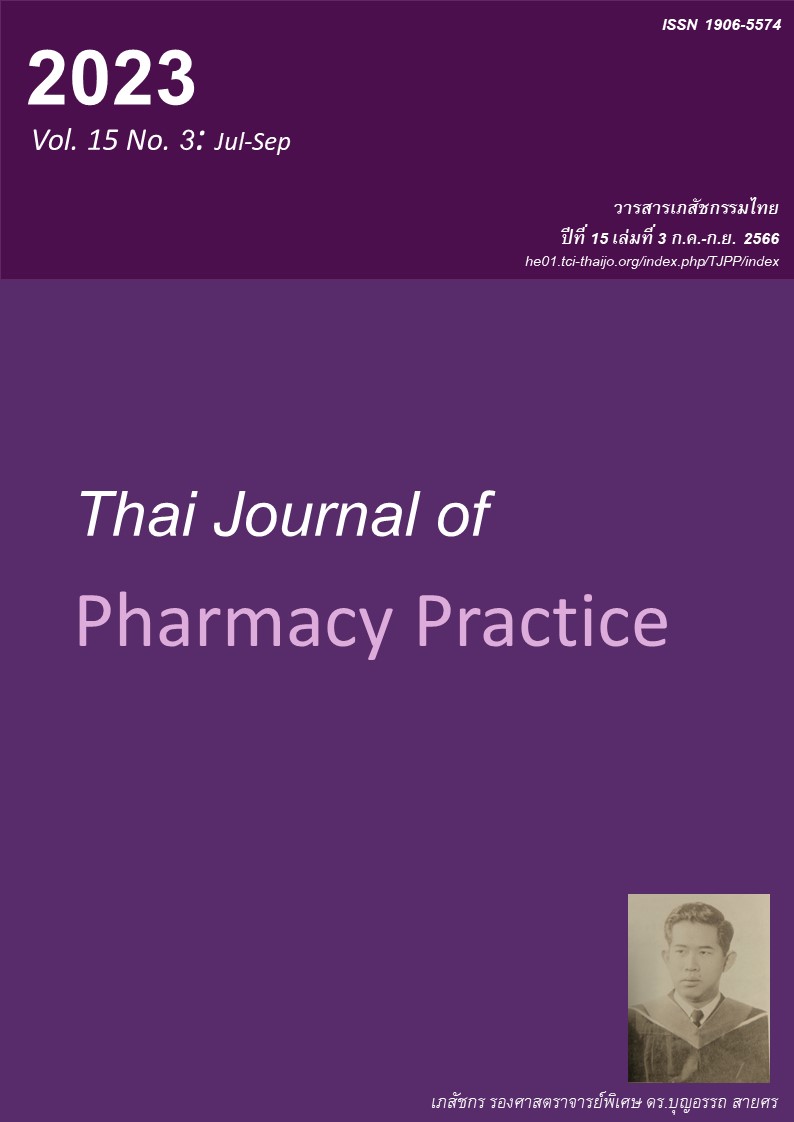ผลของการใช้ระบบดูแลผู้ป่วยที่มีภาวะพิษเหตุติดเชื้อแบบสหสาขาวิชาชีพของโรงพยาบาลรามาธิบดี
Main Article Content
บทคัดย่อ
วัตถุประสงค์ : เพื่อเปรียบเทียบระยะเวลาที่ผู้ป่วยได้รับยาต้านจุลชีพแบบคาดการณ์ครั้งแรกก่อนและหลังการเริ่มใช้ระบบดูแลผู้ป่วยที่มีภาวะพิษเหตุติดเชื้อของโรงพยาบาลรามาธิบดี (Ramathibodi Sepsis System: RSS) และศึกษาระยะเวลาในการได้รับยาต้านจุลชีพที่เหมาะสมกับผลเพาะเชื้อ อัตราการเสียชีวิตในโรงพยาบาล อัตราการเสียชีวิตใน 28 วัน และระยะเวลาในการนอนโรงพยาบาล วิธีการ : การศึกษานี้เป็นการวิจัยกึ่งทดลอง ที่วัดผลช่วงก่อนและหลังการใช้ระบบ RSS ในผู้ป่วยที่มีภาวะพิษเหตุติดเชื้อที่เข้ารับการรักษาในโรงพยาบาลรามาธิบดี ระหว่างวันที่ 29 มกราคม พ.ศ. 2564 – 30 เมษายน พ.ศ. 2565 ระบบ RSS เป็นการทำงานร่วมกันของสหสาขาวิชาชีพที่ให้บริการแบบองค์รวม ประกอบด้วย 1) การกำหนดแนวทางมาตรฐานในการวินิจฉัยเพื่อทำให้วินิจฉัยการเกิดภาวะพิษเหตุติดเชื้อได้รวดเร็ว 2) มีการกำหนดรายการยาต้านจุลชีพเพื่อบรรจุในเครื่องจ่ายยาอัตโนมัติซึ่งจัดตั้งอยู่ ณ บริเวณหอผู้ป่วย เพื่อให้ขั้นตอนการตรวจสอบคำสั่งใช้ยาและการจ่ายยา และ 3) การตรวจสอบผลความไวของเชื้อต่อยาต้านจุลชีพที่ผู้ป่วยได้รับเพื่อให้ผู้ป่วยได้รับยาต้านจุลชีพที่เหมาะสมกับเชื้อก่อโรค ผู้ป่วยที่ผ่านเกณฑ์คัดเลือกเข้าร่วมการศึกษาจำนวน 137 คน แบ่งเป็นกลุ่มก่อนใช้ระบบ RSS 50 คน (กลุ่มควบคุม) หลังใช้ระบบ RSS 87 คน (กลุ่มศึกษา) การศึกษาเปรียบเทียบระยะเวลาที่ผู้ป่วยได้รับยาต้านจุลชีพแบบคาดการณ์ครั้งแรกในช่วงก่อนและหลังมีการใช้ระบบ RSS ผลการวิจัย : กลุ่มศึกษามีระยะเวลาในการบริหารยาต้านจุลชีพแบบคาดการณ์ครั้งแรกของผู้ป่วยเท่ากับ 42 (IQR 21.5,57.5) นาที ซึ่งน้อยกว่ากลุ่มควบคุมอย่างมีนัยสำคัญทางสถิติ กลุ่มศึกษามีระยะเวลาในการบริหารยาต้านจุลชีพที่เหมาะสมตามผลเพาะเชื้อ เท่ากับ 48 ( IQR 0.9,84.0) ชั่วโมง ซึ่งน้อยกว่ากลุ่มควบคุมอย่างมีนัยสำคัญทางสถิติ อัตราการเสียชีวิตในโรงพยาบาล อัตราการเสียชีวิตใน 28 วัน และระยะเวลาในการนอนรักษาตัวในโรงพยาบาลในกลุ่มศึกษาลดลง เมื่อเทียบกับกลุ่มควบคุมแต่ไม่มีนัยสำคัญทางสถิติ สรุป: การนำระบบ RSS มาใช้ในการดูแลผู้ป่วยที่มีภาวะพิษเหตุติดเชื้อช่วยลดระยะเวลาในการบริหารยาต้านจุลชีพแบบคาดการณ์ครั้งแรก และลดระยะเวลาในการบริหารยาต้านจุลชีพที่เหมาะสมตามผลเพาะเชื้อได้อย่างมีนัยสำคัญทางสถิติ ส่งผลให้อัตราการเสียชีวิตในโรงพยาบาล อัตราการเสียชีวิตในที่ 28 วัน และระยะเวลาในการนอนโรงพยาบาลในกลุ่มศึกษามีแนวโน้มลงได้เมื่อเทียบกับกลุ่มควบคุม แต่ยังไม่มากถึงระดับที่มีนัยสำคัญทางสถิติ
Article Details

อนุญาตภายใต้เงื่อนไข Creative Commons Attribution-NonCommercial-NoDerivatives 4.0 International License.
ผลการวิจัยและความคิดเห็นที่ปรากฏในบทความถือเป็นความคิดเห็นและอยู่ในความรับผิดชอบของผู้นิพนธ์ มิใช่ความเห็นหรือความรับผิดชอบของกองบรรณาธิการ หรือคณะเภสัชศาสตร์ มหาวิทยาลัยสงขลานครินทร์ ทั้งนี้ไม่รวมความผิดพลาดอันเกิดจากการพิมพ์ บทความที่ได้รับการเผยแพร่โดยวารสารเภสัชกรรมไทยถือเป็นสิทธิ์ของวารสารฯ
เอกสารอ้างอิง
Singer M, Deutschman CS, Seymour CW, Shankar-Hari M, Annane D, Bauer M, et al. The third international consensus definitions for sepsis and septic shock (Sepsis-3). JAMA. 2016; 315: 801-10.
Angus DC, Linde-Zwirble WT, Lidicker J, Clermont G, Carcillo J, Pinsky MR. Epidemiology of severe sepsis in the United States: Analysis of incidence, outcome, and associated costs of care. Crit Care Med. 2001; 29: 1303-10.
Wang HE, Shapiro NI, Angus DC, Yealy DM. National estimates of severe sepsis in United States emergency departments. Crit Care Med. 2007; 35: 1928-36
Rudd KE, Johnson SC, Agesa KM, Shackelford KA, Tsoi D, Kievlan DR, et al. Global, regional, and national sepsis incidence and mortality, 1990–2017: analysis for the Global Burden of Disease Study. Lancet. 2020; 395: 200-11.
World Health Organization. Global report on the epidemiology and burden of sepsis: current evidence, identifying gaps and future directions [online]. 2020 [cited July 8, 2021]. Available from: apps.who.int/iris /handle/10665/334216
Rhee C, Dantes R, Epstein L, Murphy DJ, Seymour CW, Iwashyna TJ, et al. Incidence and trends of sepsis in US hospitals using clinical vs claims data, 2009-2014. JAMA. 2017; 318: 1241-9.
Strategy and Planning Division, Office of the Permanent Secretary, Ministry of Public Health. Public health statistics [online]. 2019 [cited Nov 11, 2021]. Available from: bps.moph.go.th/new_bps/sites /default/files/statistic62.pdf
Kumar A, Roberts D, Wood KE, Light B, Parrillo JE, Sharma S, et al. Duration of hypotension before initiation of effective antimicrobial therapy is the critical determinant of survival in human septic shock. Crit Care Med. 2006; 34: 1589-96.
Rhodes A, Evans LE, Alhazzani W, Levy MM, Anto- nelli M, Ferrer R, et al. Surviving sepsis campaign: International Guidelines for Management of Sepsis and Septic Shock: 2016. Intensive Care Med. 2017; 43: 304-77.
Subcommittee on the Care of Sepsis, Ramathibodi Hospital. Ramathibodi sepsis protocol [online]. 2018 [cited July 8, 2021]. Available from: sites.google.com/ mahidol.edu/ramasepsis.
Evans L, Rhodes A, Alhazzani W, Antonelli M, Coo persmith CM, French C, et al. Surviving sepsis campaign: international guidelines for management of sepsis and septic shock 2021. Intensive Care Med. 2021; 47: 1181-247.
Faul F, Erdfelder E, Lang AG, BuchnerA. G*Power 3: A flexible statistical power analysis program for the social, behavioral, and biomedical sciences. Behav Res Methods, 2007 39, 175-91
Lertvipapath P, Puttilerpong C, Werarak P, Chakorn T, Angkasekwinai N, Noppakusomboon N. Compari- son of clinical characteristics and treatment outcomes of sepsis or septic shock patients between those diagnosed by 2012 criteria and those by 2016 criteria. Thai Journal of Pharmacy Practice 2017; 9: 206-15.
Lueangarun S, Leelarasamee A. Impact of inappro priate empiric antimicrobial therapy on mortality of septic patients with bacteremia: A retrospective study. Interdiscip Perspect on Infect Dis. 2012; 2012: 765205.
Dagher GA, Saadeldine M, Bachir R, Zebian D, Chebl RB. Descriptive analysis of sepsis in developing country. Int J Emerg Med. 2015; 8: 19.
Suttapanit K, Dangprasert K, Sanguanwit P, Supata nakij P. The Ramathibodi early warning score as a sepsis screening tool does not reduce the timing of antibiotic administration. Int J Emerg Med. 2022; 15: 18.
National Antimicrobial Resistance Surveillance, Thai land. Prevalence of antimicrobial resistent bacteria in 2000-2020 [online]. 2021 [cited Nov 11, 2021]. Available from: narst.dmsc.moph.go.th/data/AMR%20 2000-2020-12M.pdf
Sterling SA, Miller WR, Pryor J, Puskarich MA, Jones AE. The impact of timing of antibiotics on outcomes in severe sepsis and septic shock: A systematic review and meta-analysis. Critical Care Med. 2015; 43: :1907-15
Joo YM, Chae MK, Hwang SY, Jin S-C, Lee TR, Cha WC, et al. Impact of timely antibiotic administra tion on outcomes in patients with severe sepsis and septic shock in the emergency department. Clin Exp Emerg Med. 2014;1: 35-40.


